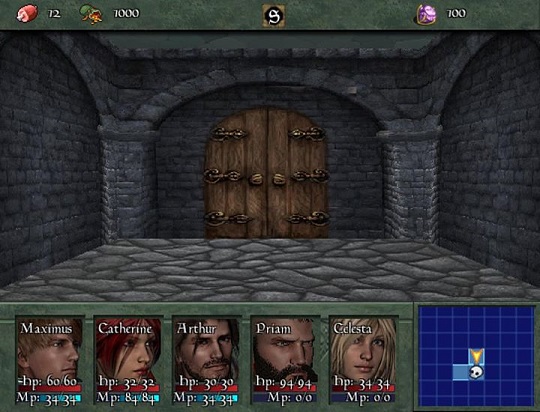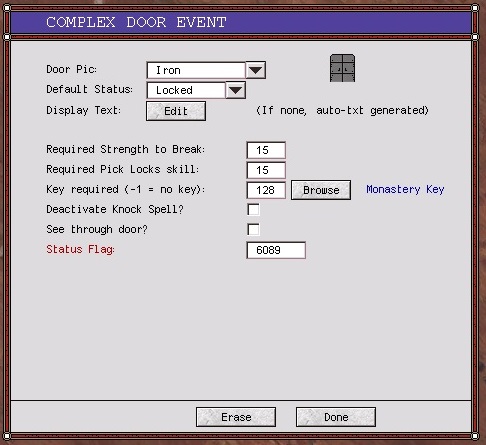I recently came across a posting on the Legend of Erthia Facebook page where the creator mentioned sarcophagi in the game which could only be opened with sufficient strength. Someone commented: “Cool, I’ll use that idea in my own game.” Well, as one of the objectives of this site is to give RPG creators just that sort of inspiration (at least I hope I can do so), I thought I’d pick up on this. In how many ways can you seal a door?
Enter if you dare (from Legend of Erthia).
…Actually, the way of sealing is probably the wrong end to start with. The ways to open a door are usually far more relevant to the player, and they are by no means limited by the kind of the lock on the door. In fact, if there is a limit of opening methods, it is most likely set by flavor: if we are talking about a standard wooden door with a standard lock, the “Dispel Magic Field” spell probably won’t do any good, just as a lockpick won’t help with a door that’s magically sealed. At least, that would be the players’ expectation, set by dozens of previous CRPGs; if you defy that expectation, you’d better have a good reason for it (and communicate it to the players rather soon).
Doors determine the player’s path through your dungeon like nothing else. This also means that they have the greatest chance to become bottlenecks, especially if the dungeon is very linear. If you implement only one way to open such a door, and that way is a difficult puzzle or an item hidden very well in another location (to name some examples), the risk of players getting stuck obviously increases a lot. In the sub-genre of pure dungeon crawlers (Dungeon Master, Legend of Grimrock), such bottlenecks comprise an essential element of the puzzle-heavy gameplay. If your game is mostly story-driven, however, you may wish to offer alternate methods or only place such bottlenecks to block access to optional and potentially highly rewarding areas. Otherwise, you just keep players from enjoying what they actually came for. (A prime example for this would be the absolute counterpart to Legend of Grimrock, namely To the Moon, which contains only very few, very minimalistic “puzzles” so the player is not completely passive; including Grimrock-style puzzles would completely run contrary to the intended experience.)
Note that offering only one method to open a specific door doesn’t automatically make it a bottleneck. There may be completely alternate passages which offer their own obstacles, maybe giving the player the choice of either finding the specific key or deal with a bunch of nasty monsters. The whole dungeon might be an optional side quest. And then, sometimes you will even want to have the bottleneck, mostly to direct the player; making sure they have visited all parts of the dungeon before they can proceed, for instance.
In most cases, giving the player options is preferrable, doubly so if it cannot be guaranteed that the player has access to certain options, be it items or character abilities. Therefore, what follow is a list of options which might open certain doors. Of course, as mentioned above, not each option makes sense for every door. Mix and match as you see fit.
(Editing the options of a Dark Disciples II door: Breaking the door, picking the lock, using a key or casting a Knock spell. If “See through door” was checked, you could also use Teleport spells to access the other side, but that would seem more appropriate for a portcullis than for such a solid door.)
- Unlock the door (with matching key)
- Pick the lock (with lockpick and sufficient character ability)
- Break the door (with sufficient character ability, usually strength)
- Cast an unlock spell (requires spell knowledge, but maybe also a certain character ability if the magic skills of the caster must be greater than the power of the door-sealing enchantment)
- Cast an unlock magic or a dispel field spell (for magical locks, of course; again, magic skills of the caster might be relevant)
- Cast a Teleport / Walk Through Walls spell
- Use a magic item which is then consumed (maybe just a scroll of the afore-mentioned spell, maybe a magic dwarven one-use key; maybe it works on magical doors, maybe not)
- Use a magic item which remains (but maybe it has only limited charges)
- Trigger the appropriate lever / button / other mechanism (which may or may not be hidden)
- Say a password (which may or may not be obvious, at which point this could count as a puzzle as well)
- Solve a puzzle (…that part will need a different posting)
- Defeat the magician who created the magical field that keeps the door locked
To add another level, the door might also be hidden (i.e. a secret door): The first problem would be to recognize the door as such, which sometimes may not even be possible until after you triggered the opening mechanism (“hey, that corridor wasn’t there before”). Possible ways of finding such a door:
- Recognize the door by character ability (Perception, Spot Secret Doors…)
- Cast a reveal spell
- Use / carry / wear a revealing item (Glasses of Truesight, spell scroll)
- Trigger a mechanism
- Run into walls (the brute force method; this should probably not be an option unless there are ways to deduce where the door might be)
Finally, there is the option of installing a trap at the door. If the trap is inevitably deadly, it is basically a different way of a lock as you must execute a special action to continue forward. Keep in mind, though, that failing to open a lock just keeps you outside, while failing to notice or disarm a trap can be potentially deadly and thus infinitely more frustrating to the player. Dealing with a trap:
- Find the trap (as with secret doors)
- Disarm the trap by your own means (character ability, spell or item)
- Disarm the trap by means of the dungeon (mechanism, puzzle, password)
- Trigger the trap (if it’s not deadly; this is a real “brute force” option that an actual lock doesn’t allow for)
By the way, all of these options can apply to anything locked, not only doors; locked chests and trapped vaults are common. And if someone would really wish to keep a certain treasure safe, he might install lots of secret and trapped locked doors. Just note that hiding all the loot within invisible, magically locked treasure chests enchanted with a petrification spell might lead to a lack of playtesters pretty soon.
Happy crafting!


